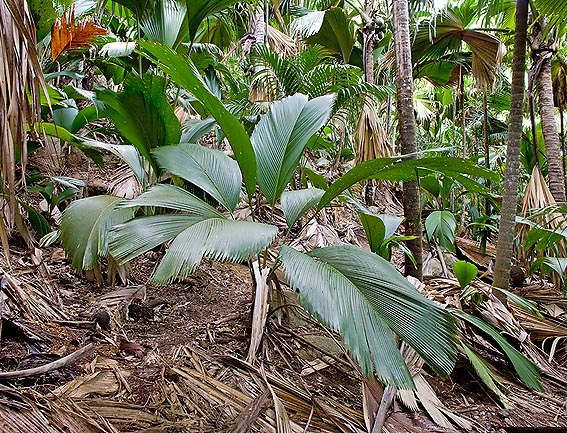Family : Arecaceae

Text © Pietro Puccio

English translation by Mario Beltramini

Endemic of the Seychelles and much decorative. But for the Tropics only © Giuseppe Mazza
The name of the genus comes from the combination of the Greek words “phoenix” and “phorios” = stolen, with reference to the theft of one of the first specimen introduced in Europe, from the Kew Gardens, later “appeared” in the private greenhouse of the German industrialist and passionate hortoculturist August Borsig (1804-1854), from where comes the name of the species.
It is locally known as “latanier feuillé”, “latannyen fey”; in the English-speaking countries as “Borsig’s palm” and “thief palm”.
Palm with solitary stem which can reach a height of 12-15 m with a diameter of about 8 cm, thickly thorny when young, less when adult, foliar sheath long 50-80 cm not wrapping completely the stem, tomentose and with blackish thorns tending to disappear with the age, as well as the petiole, long up to 40 cm, of orange yellow colour in the young plants. The leaves, elegantly curved, of a pale green colour, are long up to more than 2 metres and wide 1 m, with full bifid lamina and indented margins, which tends to part irregularly in segments more or less numerous due to the action of the wind.
The inflorescence, very ramified, develops under the leaves and is long about 1,5 metres and carries flowers of both sexes. The fruits are ovoid, about 12 mm long, of red colour when ripe. The seeds germinate in 4-5 months. Plant of a great ornamental effect, is cultivable exclusively in areas with humid tropical climate on fertile soils and in position preferably shady and sheltered from the winds.
Synonyms: Astrocaryum borsigianum K.Koch (1859); Stevensonia borsigiana (K.Koch) L.H.Bailey (1930); Phoenicophorium sechellarum H.Wendl. (1865); Astrocaryum pictum Balf.f. (1877); Stevensonia grandifolia Duncan ex Balf.f. (1877); Areca sechellarum (H.Wendl.) Baill. (1895); Astrocaryum sechellarum (H.Wendl.) Baill. (1895).
→ For general notions about ARECACEAE please click here.
